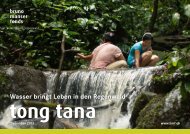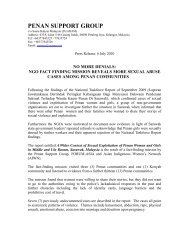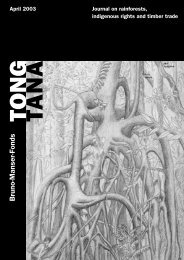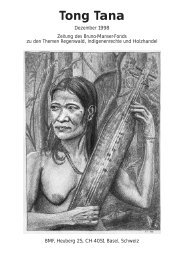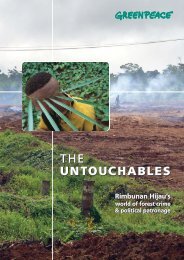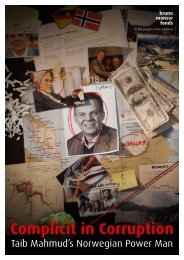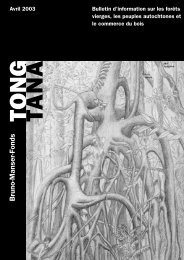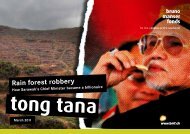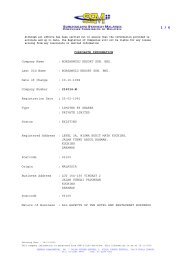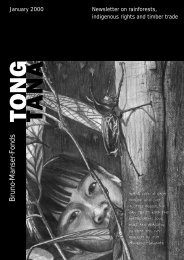Tong Tana - Bruno Manser Fonds
Tong Tana - Bruno Manser Fonds
Tong Tana - Bruno Manser Fonds
Create successful ePaper yourself
Turn your PDF publications into a flip-book with our unique Google optimized e-Paper software.
<strong>Tong</strong> <strong>Tana</strong><br />
September 1999<br />
Journal of the <strong>Bruno</strong>-<strong>Manser</strong>-<strong>Fonds</strong> on the<br />
subjects of rainforests, indigenous rights and<br />
timber trade<br />
BMF, Heuberg 25, CH-4051 Basel, Schweiz
Editorial<br />
bm – I’m on my way in beautiful Switzerland<br />
in the year 1999 AD. A McDonald’s<br />
wrapping flies out of the train window, a<br />
Coke can follows soon afterwards. “Do you<br />
find that funny” I asked the youth who realised<br />
that he had shown bravado in the<br />
wrong place. – A walk with my 78 year-old<br />
mother, who has trouble walking and uses<br />
crutches. The path in the green park is littered<br />
with garbage and glass from broken bottles<br />
after a young people’s party: father state, or<br />
rather a good foreigner, will clean everything<br />
up again. – At the edge of the Rhine river in<br />
Basel: within minutes 3 empty beer bottles fall<br />
with a plop into the dark river at night. Out of<br />
sight, out of mind. The Rhine will wash everything<br />
clean.<br />
Switzerland is one of the richest countries<br />
in the world. Federal Council member<br />
Couchepin sees further economic growth,<br />
even more production, even more consumption,<br />
as conditions for social security. Social<br />
security for whom Already three or four people<br />
successfully commit suicide in Switzerland<br />
every day.<br />
We export weapons in order to save jobs.<br />
Thanks to the war in Ex-Yugoslavia various<br />
businesses are flourishing. War boosts the<br />
economy. The economy and war are allies.<br />
The economy and politics are allies. Politics<br />
and war are allies. It is up to the Swiss politicians<br />
and every one of us to show that it need<br />
not be so, that Switzerland shows solidarity<br />
with people in the Third World protecting their<br />
and our environment. We are all in the same<br />
boat: our wonderful, beautiful planet Earth.<br />
The first proof of our honesty is transparency.<br />
All products on the market should be<br />
declared according to origin and contents.<br />
Objective information is a prerequisite for<br />
a conscious society; and only such a society<br />
will have a future in the new millenium. After<br />
the introduction of a mandatory declaration<br />
for meat, genetically modified organisms and<br />
toxic substances, the declaration for wood<br />
will be a further small step towards honesty.<br />
Only give your vote to those members of the<br />
National Council this autumn who clearly<br />
commit themselves in this sense to more transparency<br />
in commerce. The mandatory declaration<br />
has been put on the agenda for the parliamentary<br />
session in autumn after not being<br />
dealt with in the summer session.<br />
Or does nothing make sense anymore Is<br />
it too late to act Mrs Spaehnhauer said to me<br />
on the phone that, even if it is difficult at the<br />
moment, good will triumph in the end, to<br />
which I answered that we will also hold fast<br />
to this hope. “Don’t talk like this! Good will<br />
triumph! Set an exclamation mark behind it”<br />
the 82-year-old lady called out energetically.<br />
– Chapeau!<br />
And again I’m sitting on the banks of the<br />
Rhine. A drowning swallow drifts in the current.<br />
Save it Jump in Get wet The bird is<br />
certainly already dead – or not Quickly I<br />
throw off my clothes an, “splash”, the swift lies<br />
in my hand. One of its eyes is almost closed,<br />
the other tired. The body is shivering. With its<br />
beak wide open it breathes heavily. Are you<br />
dying After 1 1 / 2 hours in my hand it suddenly<br />
spreads its wings, lifts off, flies low over<br />
the surface of the water in a wide curve over<br />
the Rhine, over the roofs of the town and disappears<br />
in the distance.<br />
Contents<br />
Editorial 2<br />
Sarawak (Malaysia) 3–5<br />
The great ripening of the fruits<br />
(Tá-un Buá) 6–7<br />
Canada respects the<br />
indigenous Inuit people 8<br />
Speaking of Wood: Amazon 9<br />
Speaking of Wood: Miscellany news 10<br />
Switzerland: Mandatory<br />
declaration of timber 11–13<br />
Speaking of wood: Switzerland 14–15<br />
BMF internal affairs 16<br />
2
Sarawak (Malaysia)<br />
Message from Penan, received in<br />
May 99<br />
Ulau Ayat from Long Leng, Baa Layun:<br />
We live now in the middle of logging-companies<br />
who exploit timbers every day within<br />
our territory. They have even destroyed our<br />
fields without paying any compensation for<br />
the damage. The loggers pursue and molest<br />
us women when we pick up fruits and collect<br />
rattan and medicines.<br />
Uan Sope from Long Latei:<br />
We went to Kuching to see the Chief<br />
Minister at his residence during Hari Raya<br />
Haji. The Police brought us to their station<br />
for enquiry. We told them everything about<br />
our problems with logging and oilpalm-plantations.<br />
We wanted to ask Taib Mahmud,<br />
Abang Johari and Alfred Jabu: “How do you<br />
heal these problems” But the Police did not<br />
let us see them – and did not allow us to stay<br />
longer in Kuching, but forced us to leave for<br />
Miri and Marudi the next day.<br />
Asik Nyalik from Baa Ubung<br />
They forbid us to kill Gibbons and Hornbills<br />
– but they kill them themselves by killing<br />
the trees and the forest. Check it out yourself:<br />
before the loggers came, there were plenty of<br />
gibbons and hornbills here. They say we will<br />
profit from having our forest turned into oilpalm-plantations.<br />
I do not believe them. We<br />
have seen it, when they logged our forest –<br />
they only became rich themselves, while our<br />
life turned into poverty.<br />
Penan blockade logging-road at<br />
Long Sayan<br />
rg – The Penan had previously spoken unsuccessfully<br />
with the representatives of the logging<br />
companies. Already at the beginning of<br />
1999 the Penan had erected a blockade at<br />
the same place. It was pulled down due to negotiations<br />
with representatives of the government.<br />
This was already viewed as a success<br />
for the Penan by the local media. In the meantime<br />
the wind has changed again, the government<br />
has sent policemen to Long Sayan<br />
and the intimidated (and hungry) blockaders<br />
gave up for the time being.<br />
Penan win court case<br />
jk – The four Penan which were arrested<br />
and abused in March, ’97 (see <strong>Tong</strong> <strong>Tana</strong>,<br />
May ’99, “Violence towards peaceful<br />
Penan”) were acquitted on June 15, 1999,<br />
due to insufficient evidence. The Penan are<br />
allowed to return to their villages. The police,<br />
however, considers carrying the matter further.<br />
Alfred Jabu violating democratic<br />
law<br />
bm – According to an article in the<br />
Sarawak Tribune, Sarawak’s Deputy Chief<br />
Minister and Minister of Rural and Land<br />
Development, Dr Alfred Jabu has recently<br />
tried to cancel the traditional position of<br />
Along Sega, the headman of the Penan nomads<br />
in the Ulu Limbang region. Along Sega<br />
is one of the most eloquent speakers of the<br />
Penan. Maybe this was Alfred Jabu’s reaction<br />
on Along Sega’s complaint, that he does –<br />
regularly and already for years now – illegal<br />
hunting and fishing inside the Long Adang<br />
Wildlife Reserve, and transports plenty of fish<br />
and wildgame, on which the Penan depend<br />
for their own survival, out of the territory<br />
by helicopter. According to a message from<br />
Along in march this year, Alfred Jabu’s<br />
hunting-group has killed on a recent trip 7<br />
mousedeers (Pelanok) in one night. The nomadic<br />
Penan do not recognize the decision<br />
of Alfred Jabu as he is meddling into their<br />
internal affairs. Sources: Sarawak Tribune<br />
May 12, 1999, Headman Along Sega’s message<br />
of march 99.<br />
Trade in game remains a problem<br />
rg – Since the commercial trade in game<br />
was banned in 1998 sales have decreased<br />
in Sarawak. Dealers are fined up to about<br />
1400.– US$, buyers up to about 500 US$.<br />
Hardly any game is now being sold on the<br />
public markets of Sarawak. Nevertheless, the<br />
consumption of game during tourist tours to<br />
longhouse settlements remains a problem. As<br />
the minister of tourism, Dato James Masing,<br />
announced at the end of last year, guilty tour<br />
operators will also be punished now. Who<br />
knows whether Alfred Jabu, the hunting tour<br />
operator, will also be called to account for<br />
this<br />
Penan – waiting for reply<br />
bm – The respresentataives of the Penan<br />
from the Baram/Limbang rivers, who have put<br />
forwards their complaints and concerns after<br />
Hari Raya Haji this year in Kuching are still<br />
waiting for reply from the Chief Minister Taib<br />
3
Mahmud and from Abang Johari, the head of<br />
the Special Cabinet Committee on Penan affairs.<br />
They have asked the Chief Minister to<br />
withdraw logging licences within their territories,<br />
and to protect their forest as source for<br />
their daily food. The reply – or non-reply – of<br />
Taib Mahmud and Abang Johari will give<br />
proof, how much they respect the “poorest”<br />
part of Sarawak’s citizens.<br />
Mobile Dental Clinic –<br />
no reply so far<br />
bm – The <strong>Bruno</strong>-<strong>Manser</strong>-<strong>Fonds</strong> is also still<br />
waiting for reply on the proposal for a Mobile<br />
Dental Clinic. US$ 10,000 startcapital are<br />
ready, and the BMF is positive to find the US$<br />
140,000 necessary to run the project over<br />
two years in favour of the Penan and Kelabit<br />
in the Ulu Limbang/Ulu Baram area. The<br />
Chief Minister may appoint a dentist of his<br />
choice who likes to engage in this social project<br />
in favour of health of the Orang Ulu peoples.<br />
The Penan welcome such a project.<br />
Penan-Leaders ask for new head<br />
of Committee on Penan Affairs<br />
bm – In an article in “The Star”, Abang Johari,<br />
Head of the Committee for Penan Affairs,<br />
was quoted saying: “There are no more<br />
Penans practising shifting cultivation. Most of<br />
them are now selfsufficient in food production...they<br />
all have access to medical facilities”.<br />
Yet, in contrary to that statement, many<br />
Penan face food shortage (mainly in protein)<br />
as a result of the reduction of the wildgamepopulation<br />
due to logging-activities. Most of<br />
the Penan also have left their nomadic way of<br />
life and do nowadays shifting cultivation on<br />
advice of the Government…<br />
Several Penan leaders have been asking,<br />
that the head of the Committee on Penan<br />
Affairs, Abang Johari, should be replaced by<br />
a person, who at least understands their language,<br />
culture and needs. Sources: The Star,<br />
11/12/98, Penan-messages of march 99.<br />
Siemens interested in Bakun Dam<br />
rg – After the construction of Ekran’s USD<br />
4 million) dam project failed for lack of finances<br />
in November 1997, the government<br />
now wants to build a smaller project costing<br />
an estimated USD 1,4 billion. Representatives<br />
from Siemens have carried out preliminary<br />
talks with the Malaysian government in the<br />
hope to get contracts for turbines and generators<br />
for the 500 megawatt dam.<br />
The world’s rarest small cat<br />
in Borneo<br />
rg – The brown Borneo cat (Catopuma badia)<br />
is regarded as the rarest cat in the world.<br />
Since 1874 only a dead animal and several<br />
furs had been collected. In 1992 poachers<br />
captured a female brown Borneo cat in the<br />
border area between Sarawak and Kalimantan,<br />
keeping it in captivity for several months.<br />
It finally perished from undernourishment and<br />
was dead by the time it was brought to the<br />
museum of Kuching. Genetic analyses<br />
showed that the brown Borneo cat is indeed a<br />
separate species. At the end of 1998 another<br />
cat was caught which had fled from forest<br />
fires. It was released again at an undisclosed<br />
location.<br />
Bornean bay cat<br />
(Catopuma badia).<br />
No living specimen<br />
has been photographed.<br />
This cat,<br />
held by Dr. Charles<br />
Leh, was caught by<br />
trappers in 1992 on<br />
the Sarawak-Indonesia border, bud died before<br />
scientists could examine it.<br />
Bornean bay cat (Catopuma badia) in a 19th<br />
century painting by Joseph Wolf.<br />
4
Forestry in Sarawak<br />
Professor em. Eberhard F. Bruenig,<br />
Associate Member, Oxford<br />
Forestry Institute, Oxford University,<br />
who worked in the Sarawak<br />
Forestry Department from<br />
1954–1963 and 1990–1996,<br />
talked to John Künzli<br />
Responding to a question by <strong>Bruno</strong> <strong>Manser</strong><br />
whether the development of the forestry and<br />
forest industry could be described as catastrophic,<br />
Professor Bruenig asserted that, with<br />
respect to the development in the last three<br />
decades, this could be said with the following<br />
qualifications.<br />
Timber trade, and to a certain degree, the<br />
wood-processing industry flourished, while<br />
the forest growing stock capital was depleted<br />
quickly and drastically, at the expense of future<br />
prospects. Rash and wasteful growing<br />
stock depletion and exodus of capital caused<br />
ecological damages to site and forest stand<br />
caused by the generally careless and inadequate<br />
construction of roads and tracks, inappropriate<br />
harvesting technology, destructive<br />
logging practices and overlogging.<br />
All this could have been avoided, however,<br />
if the political will and strength had been<br />
there. Commercial interests of indigenous and<br />
foreign power-holding groups were, since the<br />
mid-1960s, primarily cash-flow orientated.<br />
The combination of lack of governmental control,<br />
ready markets, pressing buyers and the<br />
in theory free but in reality manipulated and<br />
distorted markets, was ideal for those who<br />
cleverly and in many ways were out to maximise<br />
private profits. The position of the<br />
power-holders was strong enough to fend off<br />
any outside interference. Even the Malaysian<br />
Federal Government found it difficult to make<br />
itself heard. This only changed with the emergence<br />
of the rainforest movements in the international<br />
political and NGO arena. During<br />
the whole period, only a few companies had,<br />
to some extent, managed to adhere to the<br />
principles of sustainability and complied with<br />
existing rules, regulations and management<br />
prescriptions.<br />
Recently for example, the German Technical<br />
Assistance Agency (GTZ – Project FOMISS) is<br />
helping the Samling Co. to implement lowimpact<br />
logging techniques and sustainable<br />
management approaches. (However, even<br />
then, the elusive issues of social justice and customary<br />
or statutory rights of land and resource<br />
ownership remained outside the concern of<br />
Samling Co. The co-operation with GTZ<br />
effected little change.) If forest values worth mentioning<br />
are to be saved, the existing principles,<br />
codes and guidelines for sustainable management,<br />
nature conservation and environment<br />
protection must be enforced without delay in all<br />
concession areas. This would cause 20–30% of<br />
the area of Sarawak’s permanent forest estate<br />
to be automatically excluded from logging and<br />
totally protected in its pristine state as a result of<br />
excessive slopiness, water catchment and<br />
stream/river bank protection or because of<br />
particular ecological sensitivity or uniqueness.<br />
In addition, another 5–10% of each concession<br />
area would be excluded from logging for various<br />
reasons such as poor accessibility or poor<br />
quality. Another 10% outside the producing<br />
forest estate should, according to government<br />
policy, be established as national park, wildlife<br />
sanctuary or biosphere reserve. The total area<br />
of preserved pristine forest would then be very<br />
substantial in absolute and relative terms which<br />
should satisfy any conservationist, environmentalist<br />
and anthropologist.<br />
However, the reality is rather different and<br />
the forest growing stock liquidation and forest<br />
area decline continue almost unabated. Nature<br />
and forest protection have made no notable<br />
headway. The large newly designated<br />
totally protected areas are intentions which<br />
are only slowly established on the ground and<br />
largely remain on paper. Satellite images indicate<br />
that exploitation of Sarawak’s forests<br />
progressed rapidly and engulfs many areas<br />
which should, under any circumstance and aspect,<br />
be totally protected. This causes not only<br />
damage to the sites, forests, environment and<br />
water bodies, but also irreversibly destroys<br />
unique heritage sites and ecosystems.<br />
The Environmental Impact Assessment<br />
(EIA) which is mandatory for any forestry operation<br />
above a specified size is applied reluctantly<br />
or entirely circumvented. Of particular<br />
ecological and economical alarm are the<br />
continued exploitation and destruction of the<br />
fragile Alan-Peatswamp forest ecosystems<br />
which are unique as ecosystem and global<br />
heritage, and the hazardous plan to replace<br />
all types of natural peatswamp forest by<br />
agricultural plantations. A credible and well<br />
implemented EIA and certification would<br />
probably stop the former and prevent the<br />
latter. However, a hopeful sign that a wind of<br />
change is blowing effectively, is the activity<br />
in recent years of the Malaysian Federal<br />
Government towards a national scheme of<br />
certification to support development towards<br />
sustainable forest management and conservation.<br />
5
The great ripening of the fruits<br />
(Tá-un Buá)<br />
bm – Penan nomads live off hunting all<br />
year round – mainly wild boars – and off<br />
sago, a starchy flour from wild palms. Only a<br />
few trees blossom annually in the wild; the<br />
monkeys are usually faster than the people in<br />
plucking their fruit. In intervals of about 5–7<br />
years, however, the whole jungle with all its<br />
noble fruit trees turns into a paradise! There is<br />
food in abundance for months, as the game<br />
also follows the blessing of fruit. 1998/99<br />
was such a year of good fortune.<br />
As the hornbill bird (metui) heralds the arrival<br />
of the large troops of wild boars, the<br />
Penan know that an abundant fruit season is<br />
near by the sight of so-called “root flowers” at<br />
the foot of the Meranti tree. In such a year the<br />
Penan’s needs in vitamins and sweets are met<br />
beyond fulfillment. Over a hundred kinds of<br />
fruit, some of them very nourishing, ripen in<br />
alternating sequence. Among the first gifts are<br />
the Cu-ui balls [ill. 1], beckoning in the low-lying<br />
areas, looking somewhat like mirabelle<br />
plums from far. Those who dare to try the unripe<br />
fruit soon have their teeth full of yellow<br />
resin and the sensation of “long teeth” (kennilou),<br />
caused by the fruit’s acids, signal restraint.<br />
The end of the fruit blessing half a year<br />
later is marked by the date-like blue-black Keramen-Paiáh<br />
fruit in the mountains. They become<br />
nicely sweet after boiling water is<br />
poured over them.<br />
During the fruit season nobody wants to<br />
stay in the settlement. Four-year-old children<br />
even shoulder a rattan bag and join a little<br />
troop for a playful walk through the jungle.<br />
Whoever can climb does so. Even some pregnant<br />
Penean women can climb. For what is<br />
more wonderful than to sit up in a tree in the<br />
Their thin skin does not weigh much during<br />
transport and their ripe sweet juicy meat<br />
smells like the behinds of the Sogok ant (Bo<br />
sak Lotok Sogok). The bitter bark of the tree is<br />
used for treatment of malaria; the green seed<br />
is an ingredient for arrow poison.<br />
A whole row of coveted fruits of lianas,<br />
especially Pellutan species, hang like oranges<br />
in the branches. But their harvest is dangerous,<br />
even when the mother-tree is felled. The<br />
copiously flowing milky sap leaves black<br />
spots on the skin. The latex of the “Pellutan<br />
Unga” liana [ill. 3] is used as a soap: When<br />
applied to the<br />
skin it binds the<br />
other types of latex<br />
and can be<br />
rubbed off when<br />
dry. Watch out:<br />
the method does<br />
not work for hairy<br />
bodies!<br />
About 20 wild<br />
types of Rambuill.<br />
1: Cu-ui fruit<br />
fork of a branch and<br />
fill your belly with<br />
sweet fruit and on top<br />
of that to enjoy the<br />
view in the soft<br />
breeze A few daredevils<br />
can always be<br />
found for dangerous<br />
trees who will get the<br />
fruit to fall by shaking<br />
branches with barbed<br />
sticks or just by chopping<br />
down branches<br />
high up in the tree’s<br />
crown. Unfortunately,<br />
abundant trees such as<br />
Cu-ui, or trees which<br />
can hardly be climbed<br />
like Beripun, or Peta<br />
are also felled in order<br />
to get at the fruit.<br />
One of the noblest<br />
of fruits is the Buá Jet<br />
(Langsat, ill. 2), which<br />
is also cultivated.<br />
ill. 2:<br />
Buá Jet with ant<br />
ill. 3: Pellutan<br />
Unga liana<br />
6
tan beckon. Some glow like flaming red<br />
heads of hair in a green sea of leaves. “Thick<br />
is the skin of the Maha fruit, but sweet its<br />
flesh!” (Kapan ipa buá Maha, tapi mee<br />
luneng néh) says the song to honour a woman<br />
who is not the most beautiful at first sight but<br />
has inner qualities.<br />
In contrast to<br />
the cultivated<br />
Rambutan Kahwin,<br />
the flesh of<br />
the wild fruit [ill.<br />
4] does not easily<br />
come off the<br />
almond-sized<br />
seed. Whoever<br />
does not want<br />
to swallow it<br />
chews the meat<br />
and the sweet<br />
juice off the<br />
seed with his<br />
front teeth. The<br />
ill. 4: Wild Rambutan fruit<br />
only shadow<br />
over this fruit<br />
paradise is the<br />
fact that an astounding<br />
number of young Penan already<br />
have damaged teeth from the fruits’ acids and<br />
urgently need treatment.<br />
The thick skin of a whole family of nut-sized<br />
to peach-sized fruits (Buá Ipa, ill. 5) opens under<br />
pressure into three segments. When fruit<br />
is plentiful only its flesh is collected in a bamboo<br />
container, the contents of which turn into<br />
a sweet alcoholic drink<br />
after 2–3 days (Borak<br />
Buá). Fermentation can<br />
be enhanced through<br />
the addition of a middle<br />
section of a Nakan<br />
fruit. Unfortunately, the<br />
production of this drink<br />
by the Penan, resembling<br />
fermenting grape<br />
juice, was forbidden by<br />
the Christian mission<br />
SIB.<br />
The largest and most<br />
nourishing fruits of the<br />
jungle are summarised<br />
by the Penan as Buá<br />
Jato (fallen fruit). The<br />
most well-known – or<br />
ill. 5: Buá Ipa fruit<br />
the most infamous – of them<br />
is the Durian, head-sized, 1–2 kg heavy and<br />
spiked. It mainly grows on large trees and exists<br />
in types with white, yellow and red flesh<br />
[ill. 6]. Overripe fruit smell like vomit. Neither<br />
hotels nor airlines permit them in the luggage.<br />
Whoever does not (yet) know it, finds it disgusting.<br />
Whoever dares to try it can become<br />
addicted after<br />
the third time.<br />
All indigenous<br />
people love it<br />
and there is<br />
hardly a child<br />
who will not lick<br />
the smeary flesh<br />
from its fingers.<br />
A tree can provide<br />
several<br />
ill. 6: Bela fruit<br />
hundred fruits<br />
and feed a family<br />
for 2 weeks.<br />
For easy transport<br />
only the inside<br />
of the spiky<br />
fruit is carried<br />
home in a leafy package. The flesh can be<br />
dried to a black-brown dough over a fire and<br />
be preserved (dusi). The eyeball-sized seeds<br />
used to be cooked, peeled and dried over the<br />
fire as provisions for later (gurem).<br />
The Nakan fruit (jackfruit, ill. 7) are as fine<br />
as the Durian. Looking like huge hanging<br />
breasts, they grow directly<br />
from the trunk<br />
which, according to<br />
the myth, was once a<br />
Penan woman.<br />
When a group returns<br />
to the settlement<br />
from an expedition,<br />
part of the harvest is<br />
shared with all the<br />
other families and the<br />
feast of fruits continues.<br />
Although the<br />
Penan nomads do not<br />
pursue agriculture,<br />
they become gardeners<br />
during the fruit season:<br />
as the seeds of<br />
eaten fruits are spit out<br />
or land in the bushes<br />
after passing through<br />
the digestive tract, a<br />
new fruit garden soon<br />
sprouts in and around<br />
the settlement!<br />
ill. 7: A Penan boy<br />
plucks Nakan fruit<br />
7
Canada respects the rights of<br />
indigenous Inuit people<br />
Canada makes a start !<br />
rg – Since 1.4.99 the Inuit, formerly known<br />
as Eskimos (raw meat eaters), were granted<br />
a politically self-contained territory within<br />
Canada.<br />
With an area of around 2 million square<br />
kilometres (approximately 50 times bigger<br />
than Switzerland) and with around 27 000<br />
dwellers, the new territory named “Nunavut”<br />
(our land) is extreme sparsely populated.<br />
From the 56 000 Inuit living in Canada,<br />
23 000 now live in Nunavut. The landscape<br />
is stamped by lakes, tree-free polar prairie<br />
and plains and cliffs on the Arctic coast.<br />
Nunavut has been tagged as one of the<br />
world’s most promising mining areas. There<br />
are big deposits of resources like zinc, lead,<br />
silver, gold and diamonds that are already<br />
partially exploited. Through the transfer of<br />
prospecting rights, the Inuit receive from the<br />
Canadian government over the next 14 years<br />
a total of 1.15 billion dollars. Apart from that<br />
the government will take over 90% of the territory’s<br />
expenses in the next years. The Inuit’s<br />
culture has changed a lot in the past years:<br />
monies provided to them by the government<br />
up to social housing assisted to the Inuit’s estrangement<br />
from their traditional lifestyle. Nomadic<br />
camps and dog sleighs have been replaced<br />
by permanent housing estates and motor<br />
sledges. The official language will indeed<br />
be Inuktitut, and although not only the well educated<br />
inhabitants often prefer English, many<br />
The Inuit hunt in kayaks<br />
traditions are preserved specially by the elders.<br />
Because of the language barrier the<br />
younger Inuit find it hard to discuss with their<br />
grandparents. Demand for drugs and other<br />
consume-possibilities is spreading.<br />
NUNAVUT, our Land<br />
Map: NZZ<br />
<strong>Tong</strong> <strong>Tana</strong><br />
Published by<br />
<strong>Bruno</strong>-<strong>Manser</strong>-<strong>Fonds</strong> (BMF)<br />
Society for the peoples of the rainforest<br />
Heuberg 25, CH-4051 Basel, Switzerland<br />
Telephone ++41(61)261 94 74<br />
Fax ++41(61)261 94 73<br />
E-mail: info@bmf.ch<br />
Internet: www.bmf.ch<br />
Donations:<br />
Switzerland/Liechtenstein:<br />
Post account: 40-5899-8<br />
Coop Bank account,4002 Basel, Acct. 421329.29.00.00-5<br />
France: La Poste, Strasbourg, Acct. CCP 2.604.59T<br />
Germany: Deutsche Bank, Lörrach (BLZ 683 700 34) Acct.<br />
1678556<br />
Editor: John Künzli, <strong>Bruno</strong> <strong>Manser</strong><br />
Authors: <strong>Bruno</strong> <strong>Manser</strong> (bm), Roger Graf (rg), John Künzli (jk),<br />
Ruedi Suter (rs), David Koechlin (dk), Dominik Bucheli (db)<br />
Photos: B. <strong>Manser</strong>, BMF, Zoo Zurich, D. Koechlin, IUCN,<br />
E. Bruenig, Keith Snow<br />
Drawings: B. <strong>Manser</strong><br />
Translations: Robert Gogel, M.-A. Dodd (French), Barbara Jäckli,<br />
Sara Moylan, (English), J. Künzli, B. <strong>Manser</strong> (German)<br />
Edition: 6200 (4000 German, 1500 French,<br />
700 English)<br />
Appears trimesterially<br />
Please note:<br />
Voluntary contributions are very welcome<br />
and very needed !<br />
Thank you!<br />
Printed by Gremper AG, Basel<br />
8
Speaking of wood: Amazon<br />
Ban on timber felling in Brazil<br />
a farce<br />
rg – Brazil’s Minister of the Environment,<br />
Jos‚ Sarney Filho, has partly lifted the ban on<br />
timber felling in Amazon due to pressure from<br />
the logging industry. Clear cutting continues<br />
unhindered. According to the secret service,<br />
eighty per cent of Brazil’s timber exports are<br />
from illegal sources. The remaining 20% are<br />
cut by the 377 registered logging companies<br />
which possess logging concessions for over<br />
16 000 square kilometers. Not all by far adhere<br />
to the guidelines for reforestation and<br />
careful logging techniques, as the “Neue<br />
Zürcher Zeitung” dated April 9, 1999, writes.<br />
The Malaysian timber companies WTK and<br />
Samling and the Chinese enterprise Tianjin reportedly<br />
have already bought several million<br />
hectares of forest for future logging. According<br />
to the “NZZ” all experts agree that the environmental<br />
controls have become more strict<br />
in Brazil. Whether this is sufficient to put a<br />
stop to the “timber sharks’” handiwork remains<br />
to be seen.<br />
The Amazon forest is disappearing<br />
faster than assumed<br />
rg – As reported by “Nature” in April<br />
1999, the rainforest is disappearing faster<br />
than assumed. A study questioned 1, 600<br />
people, especially owners of sawmills and<br />
Lowland tapir<br />
land owners. Additionally, aerial photographs<br />
were taken from aircraft. The researchers<br />
stated that their results were by far<br />
more reliable than the satellite photos used until<br />
now. According to the newest calculations<br />
about 44 000 square kilometers (the area of<br />
Switzerland) of rainforest were destroyed<br />
during the past year. This is almost three times<br />
the official Brazilian estimate.<br />
A split up rainforest becomes<br />
species-poor<br />
rg – Behind the front of the loggers and<br />
slash-and-burn farmers remains a rag rug<br />
landscape of patches of more or less intact<br />
forest with clear-cut and burned areas between<br />
them. Many of these small and isolated<br />
fragments are subsequently bought by environmental<br />
organisations or by the state and<br />
placed under protection. Very small areas,<br />
however, are not able to maintain the original<br />
biological/ species diversity, as the journal<br />
“Biological Conservation” (No. 89/1999)<br />
reports. Scientists investigated the number of<br />
mammals living within two large (each about<br />
20 000 hectares), two medium-sized (about<br />
2000 hectares each) and two small (about<br />
200 hectares each) rainforest fragments on<br />
the Atlantic coast of Brazil. Whereas all 36<br />
expected species of mammals were found in<br />
the large areas, 30–31 species remained in<br />
the medium-sized areas<br />
and only 22–23<br />
species were left in<br />
the smallest areas. Especially<br />
large species<br />
with low population<br />
densities roaming<br />
through large territories<br />
such as jaguars,<br />
pumas and lowland<br />
tapirs were missing in<br />
the small forested<br />
areas. Boundary effects<br />
are also especially<br />
detrimental for<br />
the small areas where<br />
a change in the temperature<br />
and wind<br />
regimes causes the<br />
microclimate inside<br />
the forest fragment to<br />
change and to foster<br />
forest fires.<br />
9
Speaking of Wood:<br />
Miscellany news<br />
No relief for Tibet’s forests<br />
rs – The deforesting of Tibet through the<br />
People’s Republic of China rages on unhindered.<br />
Daily more than a hundred cargo<br />
trucks roll along the strategic east-west axis of<br />
Lasha-Kangding-Chengdu passage downloaded<br />
with big trunks for China. Most of the<br />
trunks have diameters ranging from 40 cm to<br />
70 cm – some even over 150 cm – and are often<br />
longer than the cargo truck itself. The Chinese<br />
army also takes part in the transportation<br />
of the logs. Another method of transporting<br />
the felled trunks from Tibet to East China is to<br />
let them float down the rivers in their thousands.<br />
Tibet’s primary forest, with its broad<br />
variety of species, has been tagged by the<br />
Han Chinese as the last “wood warehouse” in<br />
China. Large mountainous areas in Tibet have<br />
already been clearcut under generally primitive<br />
logging methods. The wood taken out of<br />
Tibet is used in China for any imaginable purpose:<br />
house-constructing, ship building, paper<br />
industry, heating – and for making chopsticks.<br />
China satisfies it’s hunger for wood – since<br />
after last year’s flood catastrophe a loggingban<br />
for the upper course of the Yangze-river<br />
was spoken – with timber from military occupied<br />
regions and neighbouring countries.<br />
Batak-family<br />
Murder on Palawan<br />
rg – On 23.3.99 Thomas Adona, an elderly,<br />
highly respected representative of the<br />
Batak people on Palawan (Philippines) was<br />
murdered with a spear stab into the head by<br />
a transient Philippino who was illegally in the<br />
Batak forest looking for rattans. The murder<br />
happened in the Mangapin-camp, a settlement<br />
built by the state-authorities. Traditional<br />
living of the Batak people is increasingly<br />
dwindling. Non-local hunters, using rifles,<br />
have drastically reduced the wild boar stock.<br />
Even the collecting of rattans and Almasiga,<br />
the fruit from Cauri trees was prohibited for<br />
the Batak people through a governmental decision.<br />
The collecting-licenses are now in the<br />
hands of a few wealthy persons who hire people<br />
from the slums of the cities to collect the<br />
forest products. The murder of Thomas Adona<br />
was one of their employees.<br />
By now, practically all the Batak have compulsory<br />
been settled down. They have been<br />
christianised particularly by the “Korea Independent<br />
Baptist One Way Church”, a sect<br />
who drums into their heads that their culture is<br />
bad, uncivilised and underdeveloped. Today,<br />
only 9 Batak family groups do still live in the<br />
traditional nomadic way in the rain forest.<br />
Forest protector living with a tree<br />
for the past year and a half<br />
rg – Within the Redwood Forest, on the<br />
west coast of America, Julia Hill, nicknamed<br />
Julia “Butterfly” has been living within the<br />
leafy folds of a thousand year old Redwood<br />
for the past year and a half in a desperate<br />
struggle to protect the ancient tree and the forest<br />
from further destruction by the Maxxam Pacific<br />
Lumber Company. An avid environmentalist,<br />
Butterfly – who beseeches the protection<br />
of the remaining forest – is supported by sympathisers<br />
who bring her food, water and mail.<br />
Cameroon bans export of rare<br />
timber-species<br />
rg – On july 1 st , 1999 Cameroon put an<br />
export-ban for certain threatened timberspecies<br />
into force. Not concerned by the new<br />
regulation are Sapelli- and Ayoustrees, which<br />
make about 50% of all trees felt in Cameroon.<br />
To balance the financial losses caused by<br />
declined exports, the government intents to<br />
increase the export taxes. The main quantity<br />
of Swiss tropical timber-imports origins in<br />
Cameroon.<br />
10
Switzerland: Why a mandatory<br />
declaration of wood<br />
Why a mandatory declaration for wood<br />
bm – In Switzerland the manufacture of<br />
doors consumes the most tropical wood. 95%<br />
of all veneered doors conceal undeclared<br />
tropical wood under veneer/paint or aluminium.<br />
Even carpenters which expressly<br />
order pinewood doors receive wrongly declared<br />
doors containing concealed tropical<br />
wood like the raw door type shown here from<br />
Entla AG in Entlebuch.<br />
Very cheap picture frames from tropical wood<br />
in the “Bastelzentrum” in Berne (large handicraft<br />
shop). Neither species nor origin of the<br />
wood is declared. A local craftsman would have<br />
to demand ten times the price just to cover costs!<br />
“Entla” door on the Bundesplatz in Berne<br />
The issue is the<br />
consumer’s<br />
right to objective<br />
information.<br />
Neither the<br />
handicraft shop<br />
“Bastelzentrum”<br />
nor Spiess/IDEA<br />
declare illustrated<br />
commodities<br />
according to<br />
species and origin.<br />
All products<br />
are made of<br />
local wood such<br />
as beech, maple<br />
and lime-wood, presumably from Swiss<br />
forests. A clear declaration in this case would<br />
be an advantage on the mark<br />
Claraspital (a hospital) in Basel: Like most<br />
doors in Swiss hospitals, these are made of<br />
tropical wood.<br />
Like in this “forest cherry” chest of drawers<br />
from the furniture shop Yverdon in Berne, the<br />
interior and back sides of many pieces consist<br />
of tropical wood, undeclared of course!<br />
11
Like many shops the large distributors ABM,<br />
JUMBO and Loeb sell picture and mirror<br />
frames made to measure. The salesperson<br />
from Loeb/ BE even assured us there was no<br />
tropical wood involved. The fact is, however,<br />
that over 50% of these products are made of<br />
African and Asian timber…<br />
The furniture shop Conforama in Geneva<br />
(“Where life is less expensive”) conceals its<br />
tropical wood under the label “walnut brown<br />
hue”; further indications are missing completely.<br />
Under the indication “beech decor”, “maple<br />
decor” etc., shops such as Conforama, Migros<br />
and Möbel-Pfister sell the worst junk. This<br />
consists of pollutant and energy-intensive<br />
plywood covered by a plastic wood imitation.<br />
The products are often imported from Denmark,<br />
fall apart after moving house once and<br />
become hazardous waste after that.<br />
Sweeping in front of your own door – with the<br />
right broom! Whereas the department store<br />
Loeb in Berne conscientiously declares the<br />
floor mop as beech-wood, origin Switzerland,<br />
every indication is missing on the handle: it is<br />
made of Ramin wood from the exploitation of<br />
Borneo’s rainforest.<br />
Möbel-Pfister, who already promised in 1992<br />
to completely renounce tropical wood, sell<br />
various closets containing tropical wood,<br />
as does the closet “Laura” shown here<br />
(SF 2670.–). The declaration “ash-wood light,<br />
natural veneer” of Möbel-Pfister is not a<br />
real declaration, the details of the inner door<br />
(Ramin, Malaysia) and the backside (Okumé,<br />
Cameroon) are missing, as are the countries<br />
of origin.<br />
12
JUMBO, the “heavyweight” with the largest turnover on the Swiss market<br />
for building and hobby products, simply does not declare anything!<br />
JUMBO had promised to declare all products according to species and origin by 1995.<br />
Jumbo-Markt AG then wrote us on Aug.4, 1994, “Together with our suppliers we have agreed<br />
upon putting a label with the declaration of the origin on the product in the retail shops. In this<br />
way we enable the consumer to participate in the protection of the environment independently<br />
and with personal responsibility. [...] To date 7 shops have declarations. The remainder are being<br />
prepared and will be revised by about the end of March, 1996.”<br />
This promise has not been kept, as opposed to MIGROS and Coop.<br />
In its branches in Dietlikon, Fribourg and Pratteln<br />
JUMBO misleadingly declares these wall<br />
panels made of Lauan wood from Indonesia<br />
as pinewood from Germany!<br />
The land of origin of these Ramin border<br />
strips from the exploitation of Borneo’s virgin<br />
rainforests was given as Europe. Almost all<br />
laminated or painted border strips are not<br />
declared at all. These are also made of Ramin<br />
wood from Borneo.<br />
Whereas all “Decoline”-curtain poles made<br />
of Ramin wood are not declared, the same<br />
supplier conscientiously declares a product<br />
when it is made of pinewood. Anyhow, the<br />
country of origin is missing in both cases. Is<br />
this a conscious deception of the customers!<br />
Picture frame: Behind such misleading labels<br />
as “walnut style” or “sorbet pistachio” JUMBO<br />
hides tropical wood!<br />
JUMBO’s Garden-furniture “Camping 1999”<br />
made of “hardwood” is made of timber coming<br />
from the plundering of the last remaining<br />
primary forests in Sarawak/Malaysia ...<br />
13
Switzerland – speaking of<br />
wood – with disdain!<br />
rg – The SHIV (Schweizerischer Sägereiund<br />
Holzindustrie-Verband, the Swiss association<br />
of sawmills and wood manufacturers)<br />
and the WVS (Waldwirtschaft Verband<br />
Schweiz, the Swiss forestry association) have<br />
published their annual reports of 1998. The<br />
reports are full of all kinds of snide remarks.<br />
The WVS states that the issue of labelling according<br />
to origin has been resolved by the Q-<br />
label propagated by the WVS, 85% of the<br />
wood having to be from Swiss forests. We<br />
then asked ourselves: what about the remaining<br />
15% and what about foreign wood which<br />
... priori cannot receive a Q-label Three<br />
years ago the same circles were fighting<br />
against the so-called discrimination of wood<br />
by a mandatory declaration. And now this<br />
should not be the case anymore with a onesided<br />
declaration of wood which is 85% worthy<br />
of getting a Q-label<br />
rg – Emil Mosimann, president of the SHIV,<br />
formulated his “realistic demands” for the<br />
favourable development of basic conditions<br />
for the wood manufacturing industry in the association’s<br />
annual report. Apart from fair<br />
transport conditions, research capacity at universities,<br />
a good presence at the Expo 2001<br />
and “hopefully” at Sion 2006, he called for<br />
“fair certifying partners (a. o. WWF, Pro<br />
Natura, Greenpeace, BMF, etc. – the Ed.)<br />
who are primarily interested in the actual state<br />
of the forest and forestry, not in selling labels.”<br />
The gentlemen responsible for the policies of<br />
the association never tire in repeating the<br />
same phrases about the eco-product wood<br />
over and over again like a mantra and at the<br />
same time shooting verbally at its potential<br />
partners. As long as such gentlemen do not<br />
disappear from the stage the goodwill of a<br />
wide range of consumers can (unfortunately)<br />
hardly be strengthened towards using native<br />
wood.<br />
rg – The newspaper “Neue Zürcher<br />
Zeitung” dated June 8, 1999, printed a supplement<br />
on the subject of paper manufacturing.<br />
Under the title “The forest and paper –<br />
widespread misunderstandings due to bad information”<br />
the CEO of the paper factory<br />
Biberist AG, Jürg Müller, could contribute his<br />
personal truths. Müller formulated statements<br />
such as, “Whereas in some countries outside<br />
Europe more wood is cut than can grow back<br />
in the same time span, the world’s forest land<br />
is increasing” or “There is no global lack of<br />
wood, on the contrary, in order to keep the<br />
forests in balance more wood has to be<br />
felled”. Furthermore, “It does not make sense<br />
to forbid the renewal of a forest under the<br />
pretext of wanting to save forests. It is just as<br />
misleading to leave forests in their original<br />
state without considering the economical<br />
difficulties of the owners of the forests; environmental<br />
protection should show consideration<br />
for the economy.” The fact that the latter<br />
point stated by Müller is still a common one at<br />
the end of the 20 th century seems to be clear.<br />
The assumption that economy has priority<br />
over environmental protection does not really<br />
show competence in someone who feels entitled<br />
to write about “widespread misunderstandings<br />
due to bad information on paper<br />
and the forest”.<br />
rg – The carpenters’ journal “Schreinerzeitung”<br />
dated March 25, 1999, published<br />
its views on the calls for the boycott of tropical<br />
wood under the title “The use of tropical<br />
wood: the facts”. According to the opinion of<br />
the “Schreinerzeitung”, such renunciations<br />
point in the wrong direction when measured<br />
against the main reasons for the destruction of<br />
the tropical forests – mismanagement and<br />
social ills in the tropical wood producing<br />
countries. Alleviation can only be achieved<br />
through development aid in those areas<br />
under the condition that the aid be used for<br />
the given purpose and not disappear into<br />
the pockets of corrupt government officials!<br />
That the wood industry is interwoven with the<br />
interests of a privileged class of politicians,<br />
that the land rights of local peoples are disregarded<br />
and that corruption is daily fare,<br />
are, unfortunately, all facts. The “Schreinerzeitung”<br />
indirectly confirms these facts – it just<br />
sees the use of development money as the<br />
problem...<br />
14
The import of tropical wood<br />
db – A rough estimate made by the BMF of<br />
tropical wood imports into Switzerland during<br />
the past year amounts to a minimum total of<br />
20 311 tons worth 42 million SF. This includes<br />
logs, sawn wood, plywood and products<br />
which can be identified as made out of tropical<br />
wood. Swiss customs statistics unfortunately<br />
do neither deliver any information on<br />
the type of wood used in partly finished and<br />
finished products nor on products imported<br />
into Switzerland over a third country; the imports<br />
would therefore be even higher.<br />
The miracle of Kleinlützel –<br />
this beech tree should have died but didn’t!<br />
Fireproof doors made of tropical<br />
wood Unnecessary!<br />
jk – The well-known company Precious<br />
woods advertises parts for fireproof doors<br />
made of tropical wood in the “Schreinerzeitung”.<br />
The FSC certified wood comes from<br />
the Brazilian virgin forest and should be an<br />
alternative to native oak, or, respectively,<br />
African Sipo. The BMF advises against the<br />
purchase and recommends instead the fireproof<br />
doors tested by the EMPA made of<br />
glued layers of local beechwood and poplarwood<br />
from the firm Norma Reiden AG, in<br />
Reiden/LU. Phone: 062 758 42 42; fax: 062<br />
758 42 43.<br />
Crimes against trees for snake<br />
protection project<br />
bm – There was a lack of wood just 50<br />
years ago in Switzerland. It was forbidden to<br />
go into the forest with an axe and cut firewood<br />
in many places. Thanks to the import of<br />
cheap fuels and wood from exploited virgin<br />
forests, Swiss forests are recuperating. The<br />
wood is unused and lies rotting away in many<br />
places.<br />
In the region of the Laufental (Liesberg, BL/<br />
Kleinlützel, SO) projects are being carried out<br />
which should create new habitats for the Jura<br />
viper. This endangered species of reptile loves<br />
sunny cliffs. On the one hand, undergrowth is<br />
sensibly being cut and piled on to heaps,<br />
giving the snakes and other animals good<br />
cover. On the other hand, almost all vegetation<br />
is being removed in some places in a kind<br />
of mini-clearcutting process; beech trees thick<br />
as bodies, as old as 50 years, oaks and pines<br />
as well as rather rare species of shrubs and<br />
small trees such as snowy mespilus (Amelanchier<br />
ovalis), a buckthorn (Rhamnus frangula),<br />
the wild service-tree (Sorbus torminalis)<br />
and a whitebream (Sorbus chamaemespilus/<br />
S. mougeotii) have been indiscriminately cut<br />
down and left to rot on the ground. In January<br />
the bark of the thickest, probably 300 yearold<br />
beech tree in the area has been cut off<br />
around the trunk to cause it to die. Miraculously<br />
the sap could rise up in spite of this,<br />
the buds opened in Spring and the tree still<br />
stands in full foliage today, in July!<br />
The BMF requests the manager of the project<br />
and the BUWAL to spare older (> 150<br />
years) trees, oaks and rare woody shrubs in<br />
order to enable virgin forest-like biotopes to<br />
develop in dry areas with cliffs, to cut all<br />
wood in winter and to utilise trunks sensibly,<br />
or to wait with felling until the demand for<br />
wood increases. Not only the snakes would<br />
profit from this in future.<br />
In praise!<br />
We congratulate the following communities<br />
on their decision to renounce the use of<br />
tropical wood from the exploitation of virgin<br />
forests: Aarau/AG, Gonten/AI, Kreuzlingen/TG,<br />
Neunforn/TG, Jouxtens/VD, Lutry/<br />
VD, Mex/VD, Préverenges/VD, Dürnten/ZH<br />
and Illnau-Effretikon/ZH. Apart from 4 cantons,<br />
a total of 250 communities with a population<br />
of 2 626 572 desist from using wood<br />
from the exploitation of virgin forests. Is your<br />
home community not yet included Become<br />
active – we will be happy to send you the<br />
necessary information.<br />
15
BMF Internal<br />
jk – The eighth annual general assembly<br />
took place on 26 th June. The 1998 balance<br />
sheet indicated a surplus of CHF 16 934.80<br />
– many thanks to all donators who have made<br />
this delightful result possible! After <strong>Bruno</strong> presented<br />
the annual report, the members held a<br />
discussion about possible avenues to finally<br />
secure a protected area for the Penan people.<br />
Those who wish to have a look at the annual<br />
account should contact the BMF secretariat.<br />
Thank you!<br />
dk – A VERY BIG THANK YOU to the organisation<br />
“Kein Stolz auf Tropenholz”, René<br />
Rohner and all the volunteers that helped to<br />
organise and to carry through a wonderful<br />
evening for the benefit of the BMF. An addition<br />
to the lovely atmosphere was the great<br />
diner and the entertainment of Masha Dimitri<br />
who gave us the possibility to forget our daily<br />
sorrows! The proceeds of the event was a<br />
check over CHF 10 842.50 – thank you!<br />
On the opening weekend <strong>Bruno</strong> <strong>Manser</strong><br />
will build a Penan hut. The evenings of October<br />
20 th , 1999 and of January 20 th , 2000<br />
have been designated for video presentations<br />
with a concluding lecture by <strong>Bruno</strong> <strong>Manser</strong>.<br />
Beginning at 20:00 p.m.<br />
The Free Market<br />
As much as possible and more<br />
As big as possible and bigger<br />
As fast as possible and faster<br />
As long as possible and longer<br />
More and if possible all<br />
Bigger and if possible the biggest<br />
Faster and if possible the fastest<br />
Longer and if possible the longest<br />
From a volume of poetry “Fahrlassig” by<br />
Peter Fahr, Nemesis-Verlag<br />
René, <strong>Bruno</strong> and check on an oak<br />
Merchandise for Sale<br />
dk – Video SAGO available in English now!<br />
The film by <strong>Bruno</strong> <strong>Manser</strong> is a unique document<br />
on the daily life of the Penan nomads, on the<br />
search of Sago-Palms, their staple food in the<br />
rainforest. CHF 50.–, US$ 45.–<br />
Exhibition<br />
“The Diary of <strong>Bruno</strong> <strong>Manser</strong>”<br />
This exhibition runs from September 11 th ,<br />
1999 to march 19 th , 2000<br />
Place: “Naturmuseum” Kasernenplatz 6,<br />
Luzern, Switzerland<br />
Open: Tue to Sat: 10–12 hr and 14–17 hr<br />
Sun and holidays: 10–17 hr (through)<br />
Mon: closed<br />
The Petronas Towers in Kuala Lumpur are<br />
still the highest buildings in the world.<br />
16



